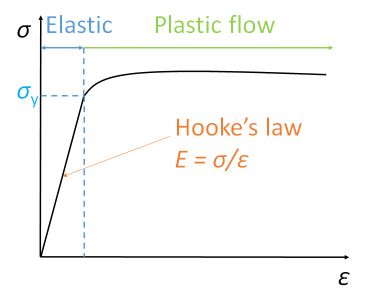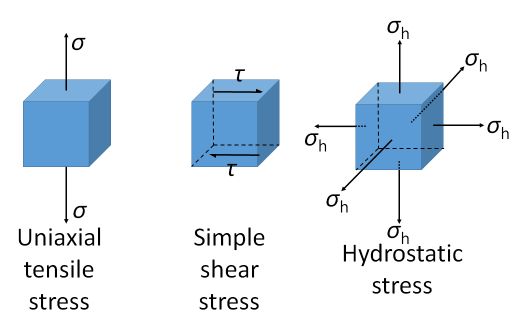Elastic deformation: Hooke's law and stiffness

Figure 8. Stress and strain curve
Elastic deformation only occurs within the elastic limit. Below the yield strength, a material can restore its original shape once the stress is removed. For most crystalline materials inside this region, the ratio of stress and strain will be constant – they obey Hooke’s law.
Hooke’s law states that the stress is directly proportional to strain. This upper limit of stress that can be applied for Hooke’s law to be obeyed is called the proportional limit. The constant ratio of stress to strain in this region is defined as Young’s modulus (SI unit: Pa), \( E \), also known as stiffness.
\[ E = \frac{\sigma }{\varepsilon} \]
Young’s modulus is a material property; it is independent of geometry and is the same for the same material. Young’s moduli of materials are usually large, and so are expressed in GPa (109 Pa). They cover a broad range from 10−3 to 103 GPa, with most structural metals having Young’s moduli between 100 and 200 GPa.
Materials possessing structural anisotropy may have different Young’s moduli in different directions. For example, woods have higher Young’s moduli when tested along the grains and lower Young’s moduli when tested perpendicular to the grains.
Similarly, we can define Shear modulus or rigidity modulus, \( G \), by
\[ G = \frac{\tau }{\gamma } \]
So far, we have seen Young’s modulus for uniaxial tension and shear modulus for forces coplanar with a material's cross section. There is one more elastic constant, describing the volume change, namely, bulk modulus, \( K \), defined as the ratio of hydrostatic stress, \( \sigma_{\rm{h}} \), to the volumetric strain, \( \Delta \):
\[ K = \frac{{{\sigma_\rm{h}}}}{{\rm{\Delta }}} \]
where hydrostatic stress consists of three pairs of equal and opposite stresses in 3D, and volumetric strain is the change in volume divided by the original volume. Their relationship can be explored further using Cartesian Tensors.
For isotropic materials, Young’s modulus and shear modulus can be related via Poisson’s ratio,
\[ E = 2G\left( {1 + \nu } \right) \]
See proof here.

Figure 9. Different stress states

